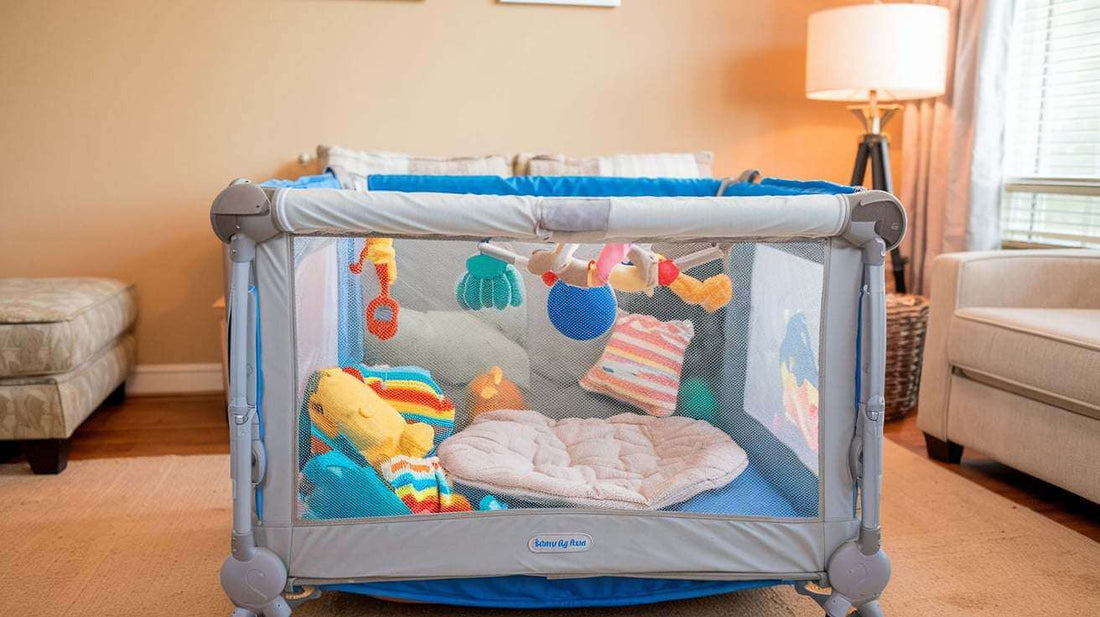Pack and Play: Dimensions, Pros & Cons, Features, and Differences from Mini Crib and Crib

Pack and Play is a versatile piece of baby gear that serves multiple purposes. This article explores what a Pack and Play is, its pros and cons, sizing considerations, and how it compares to other baby sleep options. We'll also discuss its suitability as a primary sleeping space and how long a child can use it.
What is a Pack and Play?
Pack and Play is a portable, multifunctional playpen and sleeping space designed for infants and toddlers. It features a sturdy frame with breathable mesh sides, ensuring safety and ventilation for your baby, and typically includes a firm, cushioned mattress at the bottom. The main benefits of a Pack and Play lie in its portability and adaptability. It’s designed to be easily folded and stored in a compact carry bag, making it perfect for travel, short-term stays, or even as a second sleeping space in different rooms of your home.
Pros and Cons of a Pack and Play
Pros:
- Portability: The lightweight, foldable design makes it easy to move around the house or take on the go.
- Versatility: A Pack and Play can serve as both a safe sleeping area and a play space, providing flexibility for various needs.
- Space-saving: It’s a compact option that can be tucked away when not in use, ideal for smaller living spaces or families who need an extra sleeping area for guests or travel.
- Affordability: Compared to traditional cribs, Pack and Plays are often less expensive, making them a cost-effective solution for families on a budget.
Cons:
- Durability: Pack and Plays may not be as durable as stationary cribs, especially for long-term use.
- Sturdiness: While generally safe, Pack and Plays may not feel as stable or solid as a permanent crib, particularly as your baby grows.
Do Mini Crib Mattresses and Mini Crib Bed Sheets Fit in a Pack and Play?
Mini crib mattresses are close in size to Pack and Play mattresses but are slightly larger (38" x 24" vs. 37.5" x 25.5"). While the mattress may fit, it could be too snug or leave gaps along the edges.
Mini crib bed sheets (24" x 38") may also be too large for a Pack and Play, leading to an improper fit. For safety and comfort, always use sheets specifically designed for Pack and Plays, which ensure a secure, snug fit with no loose fabric.
Will Crib Mattresses and Crib Bed Sheets Fit in a Pack and Play?
Standard crib mattresses (52" x 28") are too large for a Pack and Play and won’t fit properly, creating gaps or instability. Using a standard crib mattress could pose safety risks.
Crib bed sheets (28" x 52") also won’t fit Pack and Play mattresses. Always use bed sheets made for Pack and Plays to ensure a proper, snug fit that reduces the risk of loose fabric.
Can Toddler Mattresses and Toddler Bed Sheets Fit in a Pack and Play?
Toddler mattresses are typically the same size as crib mattresses (52" x 28"), making them too large for a Pack and Play. This would cause gaps and an insecure fit.
Toddler bed sheets (28" x 52") are also too big for a Pack and Play mattress. Use sheets specifically designed for Pack and Plays to ensure comfort and safety for your child.
Pack and Play vs. Crib vs. Mini Crib
| Feature | Pack and Play | Crib | Mini Crib |
|---|---|---|---|
| Size | 37.5" x 25.5" | 52" x 28" | 38" x 24" |
| Primary Function | Sleep and play | Sleep | Sleep |
| Portability | High | Low | Moderate |
| Durability | Moderate | High | High |
| Age Range | Newborn to toddler | Newborn to toddler | Newborn to 18-24 months |
Is a Pack and Play Suitable as a Primary Bed?
A Pack and Play can serve as a primary sleep space for your baby, offering a safe environment for sleep when used correctly. However, some parents find the mattress less comfortable than a standard crib mattress, which could affect sleep quality over long periods. While it’s a perfectly safe option, it might not be the most comfortable choice for extended nightly use.
How Long Can a Child Stay in a Pack and Play?
A child can use a Pack and Play until they exceed the weight limit (around 30 pounds) or can climb out. Typically, this is suitable for children up to 2-3 years old, depending on the child's size and development. Always follow the manufacturer’s guidelines for safe use.
Conclusion
A Pack and Play is a practical, versatile, and portable solution for parents seeking an easy-to-use, compact space for their baby to sleep or play. While it may not replace the comfort or durability of a traditional crib, its portability, space-saving design, and affordability make it a valuable tool for families. Consider your lifestyle, available space, and your baby’s needs when deciding if a Pack and Play is the right choice for your family.
